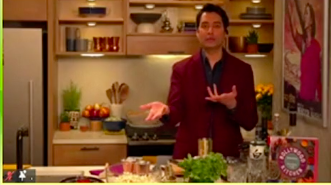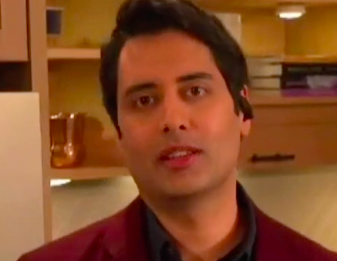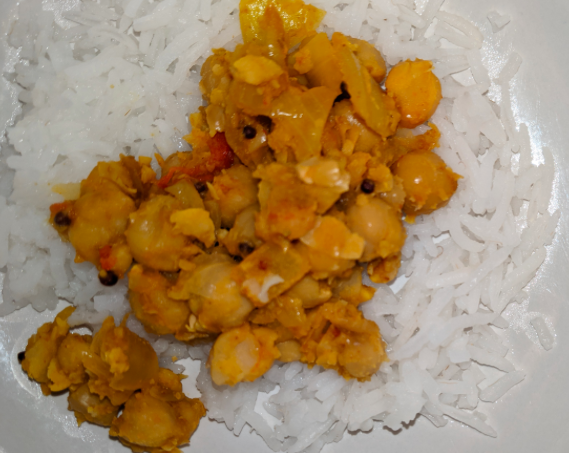Bollywood Kitchen Offers Endearing Entertainment—with a Side of Cooking
By Chef David
While the term “Bollywood” actually refers to the Hindi-language movie industry in India, some people use it to mean all of pop Indian culture, and scholars have been known to split the difference, saying it reflects a large portion of the Indian population’s desired version of reality. Nevertheless, for most of the world, it means Indian entertainment, and Sri Rao, a New York-based performer, writer, director, producer (he created the Netflix series, The Actress), and now cookbook author, has managed to bring it all home, so to speak, with Bollywood Kitchen, an on-stage cooking show that offers an intimate evening of casual conversation, Bollywood films, and food.
“Bollywood Kitchen” offers different levels of participation, eleven families can register for the Chefs Table which allows them to share the Zoom screen and interact with Mr. Rao, while others, myself included, are invisible participants watching remotely (the night I attended, 150 people were watching). We join him in his New York kitchen for 90 minutes of pure entertainment, featuring his signature Indian dishes, including chicken curry, as well as a cocktail, and chocolate chai affogato for dessert.
His World
Over a cocktail of Mumbai Mule and an appetizer of Bollywood popcorn (prepared with Indian spices, mostly coriander, and cumin), Mr. Rao presented an introduction to his world.
The son of immigrants, he grew up in the 1980s, the only Indian family in his rural Pennsylvania hometown. Additionally, he was gay, which did not make fitting in easy, until he discovered Bollywood. In his eyes, this was “a different world, filled with music, dancing, gorgeous costumes, and over-the-top melodrama.”
His first VCR inspired him, bringing the color and excitement of Bollywood movies and his parents’ Indian culture to life.

Mr. Rao welcomes us to his kitchen
Indian Food Made Simple
Then, of course, there was the food. Mr. Rao makes Indian food seem simple. Many of the participants had never prepared Indian food before, yet all of them were able to master a main dish, choosing between chicken curry or the vegetarian option, chana masala (“chana” means chickpea and “masala” refers to a blend of spices).
It would have been nice if he had prepared both the chicken and the vegetarian dish during the presentation. Instead, he chose the chicken, leaving those making the chana masala to fend for themselves.
The preparation of chicken curry began by heating oil in a blue Le Creuset Dutch Oven, adding bay leaves, properly caramelizing onions, and finally adding chicken. While the food was on the burner, guests were transported to Bollywood. Each dish matched a different story that fits with a specific movie, and this back-and-forth routine between cooking, storytelling, and movie segments was handled flawlessly.
Mothers
This is not surprising, as Mr. Rao considers himself first and foremost a storyteller who dedicated his cookbook to his mother as a way of sharing her recipes and her narrative. Like many Jewish mothers and, perhaps, many mothers everywhere, Mr. Rao’s mother did not share her recipes or attempt to preserve them by writing them down. It was up to her son to extract these family secrets and perfect them for his book, a process he feels gave his mother an “identity” all her own.
Over the years, he says, she adapted her recipes from home to use locally available ingredients, and he says she had tricks for enhancing taste, including adding salt and/or coriander.
Modest about her culinary skills, his mother says she is proud of her son and amazed that anyone would pay for his recipes. He finds it necessary to remind her that the recipes are hers.
Common Immigrant Experience
I was struck by the similarities between the Indian and Jewish immigrant experience. His parents had an arranged marriage. During the first meeting, his mother diverted her eyes and saw only the gentleman’s shoes before agreeing to the match.
Then they were separated for eight years while his father matriculated at Virginia Tech to earn a degree in Engineering and save enough to bring his bride to America. During all that time, the pair communicated through daily letters. It was an experience shared by the many European Jews who fled to America, especially in the 19th and early 20th centuries.
While many members of Mr. Rao’s audience may find it difficult to relate to his experience of being the only gay ethnic person in a rural community, I couldn’t help feeling it might not be all that different from trying to be accepted as the only Orthodox Jew in other circumstances. Being recognizably different is difficult.

Mr. Rao shares his stories
Pride in Family
All of us can appreciate Mr. Rao’s pride in his father’s accomplishments, which include leaving India in the 1950s as a pioneer blazing his way into a new culture. Here again, the story of a young man alone in a foreign country resonated with me.
Mr. Rao is sharing his story, which he has wrapped around the splendor of Bollywood and the flavors of Indian cuisine, but it left me with an understanding that each of us has a unique story that is important to share and respect.
Sitting on his couch, offering insights into his soul, which include the recognition of the sacrifices his parents made as well as the details about his first crush, he memorializes his understanding of himself as a product of his past. For me, it was evidence of his love of family, deep respect for history, and burning desire to create a living legacy: to remember the smells and sounds of his heritage.
Not a Traditional Cooking Show
An attendee, expecting a traditional cooking demonstration, is bound to be surprised not only by Mr. Rao’s personal story but also by the glimpses he gives of Bollywood musical extravaganzas.
Nevertheless, by the time Mr. Rao was through, all participants had learned how to plate the dishes using coriander to accentuate the flavor and how to eat in the traditional Indian style, using fingers to make a ball that is flicked into the mouth.
In short, Bollywood Kitchen is a high-quality production. As opposed to a simple cooking demonstration, the food here is more of a backdrop and Mr. Rao’s cookbook provides the subtext. The simplified preparation produced consistent results and charming dishes for all the participants, and although there is less actual cooking and preparation than I had been anticipating, there is no doubt that every aspect of the event was well-executed and professional.
When he is in the kitchen, the camera moves with him, showing the audience his clean knife strokes, and when he opens his pot to take a peek inside, we are there with him. The camera angles are nothing short of amazing.
When he shares his story in the living room, even if you’re watching from home, the experience is as if you are sitting there beside him on the couch. Even the mic changes are handled with delicacy and poise.
Enjoy It at Home
While participating in person could present kashruth issues for the kosher chef, this problem disappears if Bollywood Kitchen is enjoyed virtually. It presents a user-friendly experience for chefs at all stages and abilities, and the content is exotic and fun.
Tickets for Bollywood Kitchen range from $40 for the virtual presentation to $175 per household for the Chefs Table which includes a signed cookbook and prepackaged spices (which are repackaged and do not have kosher supervision). They can be obtained online at www.geffenplayhouse.org or by phone at 310-208-2028.
For the kosher chef, I would recommend selecting the video-only Bollywood Kitchen. The spices, including bay leaves, turmeric, coriander, cinnamon, and ground cloves, are easily available with suitable hechshers.
In our house, we prepared the vegetarian option the following evening, and it made for a great weeknight dinner with a side of rice.

Chana Masala by Chef David





